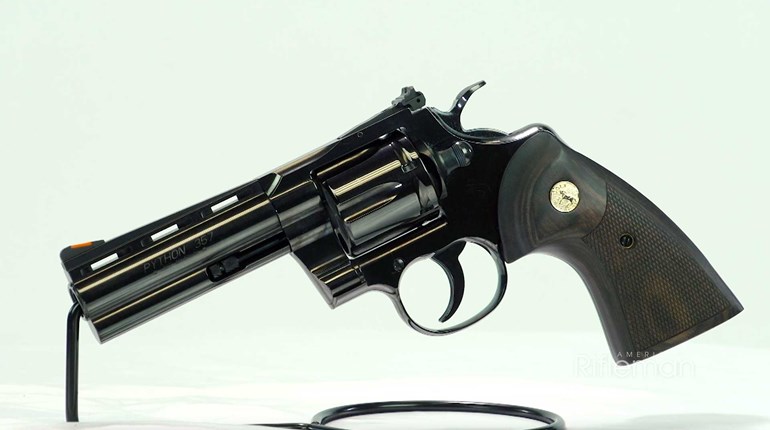
In the United States, the AR-15 is almost certainly the most-common rifle owned by private citizens in America. The rifle can be bought in nearly every configuration at every price-point for sport, hunting, self-defense or recreation and in dozens of calibers. But the genesis of the contemporary AR-15 traces its roots to the first commercially available and original AR-15: the .223 Rem. Colt SP1 rifle. Colt first commercially released the SP1 in the spring of 1964 and sold them through the late 1980s. Now ascended into the realm of vintage collectibles, the Colt AR-15 SP1 perfectly encapsulates the essence of what the original AR-15 was: lightweight, handy, soft-recoiling and easy to shoot. Unlike the traditional, walnut-and-steel rifles commonly found in that era, these early AR-15s took a radically different approach with their aircraft-grade aluminum receivers and stock-sets manufactured from modern plastics. Equally radical was its “alternative” rifle cartridge, the .223 Rem. This cartridge’s premise was to push small lighter weight projectiles to higher muzzle velocities to compensate for the lack of mass, while also having smaller footprints and increased portability.
 To a modern shooter like myself, who is used to an AR-15 carbine outfitted with modern M-Lok rails and optics, the Colt AR-15 SP1 is squarely a relic of the past. It has a longer 20-inch pencil barrel, early M-16A1 fixed carry-handle upper receiver and the iconic original furniture set including the distinctive “triangular” shaped handguards. After all, the Colt AR-15 SP1 was essentially a semi-automatic version of the original military M-16, made available to civilians. Retro-style AR-15 firearms have only increased in popularity today, and there’s something to be said for the chance to handle and shoot an actual Colt rifle in its classic and original configuration. Because the SP1 is modeled after the earliest Colt AR-15s, its upper receiver has no brass-deflector or forward assist. Their lower receivers have no fence around the magazine catch button either. The rear sight sits inside the carry-handle and is adjustable for windage only. Elevation can only be adjusted through the front sight, which in this case has a tapered profile with five-notches. Early SP1s had three-prong flash-hiders, and the rest of them have the old-school “full bird-cage” flash-hiders. The thin barrels have a 1:12-inch rifling twist and do not efficiently stabilize projectiles heavier than 55 grains.
To a modern shooter like myself, who is used to an AR-15 carbine outfitted with modern M-Lok rails and optics, the Colt AR-15 SP1 is squarely a relic of the past. It has a longer 20-inch pencil barrel, early M-16A1 fixed carry-handle upper receiver and the iconic original furniture set including the distinctive “triangular” shaped handguards. After all, the Colt AR-15 SP1 was essentially a semi-automatic version of the original military M-16, made available to civilians. Retro-style AR-15 firearms have only increased in popularity today, and there’s something to be said for the chance to handle and shoot an actual Colt rifle in its classic and original configuration. Because the SP1 is modeled after the earliest Colt AR-15s, its upper receiver has no brass-deflector or forward assist. Their lower receivers have no fence around the magazine catch button either. The rear sight sits inside the carry-handle and is adjustable for windage only. Elevation can only be adjusted through the front sight, which in this case has a tapered profile with five-notches. Early SP1s had three-prong flash-hiders, and the rest of them have the old-school “full bird-cage” flash-hiders. The thin barrels have a 1:12-inch rifling twist and do not efficiently stabilize projectiles heavier than 55 grains.
Shooting The Colt AR-15 SP1
One of my first rifle reviews on Shooting Illustrated was the Colt AR-15A4, the most modern direct descendant of the Colt SP1. It was hard not to think of the AR-15A4 when picking up the SP1, but there’s a night-and-day difference in their feel and handling. The SP1’s light-contour pencil barrel and its slightly shorter “A1 length” stock are probably the two most significant elements that made the vintage rifle stand out from the more modern one. Its shorter length of pull makes it easier to roll into the shoulder and alight the rifle’s sights with the eye smoothly, almost as if one were handling a sleek, cutting-edge 21st-century carbine instead. In this aspect the lighter weight of the pencil barrel is also noticeable too.
I shot 75 rounds of various 55-grain .223 Rem. cartridges through the SP1 including the Hornady Varmint Express loaded with V-Max bullets, Sierra Outdoor Master loaded with Sierra HPBT bullets and Federal American Eagle FMJ cartridges. At 100 yards on the bench, most groups measured approximately 4 inches tall and 2 inches wide. The Texas summer heat didn’t help matters any, but the SP1’s pencil barrel had a propensity to heat up and stay warm after shooting. Between the Sierra and Hornady cartridges, I shot a total of four 10-round groups. Two strings with “cool” bores and two strings with the barrel up to temperature. Even accounting for my eyesight and iron sights, both of the “warm” groups show a larger amount of dispersion–a target rifle this is not. Offhand, I put some standard 55-grain FMJ rounds at a more spirited pace; the specific soft-shooting recoil impulse germane to this vintage rifle left an impression on me. As a left-handed shooter, I was surprised to not be choked by a cloud of gas in my face during firing. I also wasn’t pelted by ejecting brass, despite the missing brass deflector.
The Takeaway
As a modern shooter familiar with the latest in contemporary AR-15 carbines, being able to shoot an original Colt AR-15 SP1 was a positive experience. There’s something to be said about having the chance to shoot one of the originals that’s historically functional while being able to compare it to the newer guns I shoot today. In some ways, the gun’s original smoothness and handiness surprised me, but it was also a nice reminder not to take modern optics for granted.




































